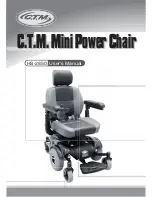
Page 3
For technical questions, please call 1-800-444-3353.
Item 67437
21.
When using Wheelchair outside and at night,
use reflective tape on Wheelchair and on
clothing. Be sure to make eye-contact with drivers
and adhere to crosswalks. It may be difficult
for some drivers to spot Wheelchair at certain
intersections; use extra caution during street use.
22.
Do not use Wheelchair on busy roads, streets or
highways. Use only on pedestrian walking areas.
23.
Scan area well ahead of Wheelchair during use.
Avoid obstacles when possible and make sure
floor areas at home and work are level. Remove
or cover threshold strips between rooms.
24.
Do not attempt to climb or descend curbs
or steps alone or without assistance
unless proficient enough to make
such maneuvers on your own.
25.
Do not attempt to climb a high curb or step
4” or higher unless you have assistance.
Attempting to climb high steps can lead to
loss of balance and potential tip over.
26.
Do not use Wheelchair on stairs without
assistance. Doing so can lead to loss of balance
and a fall, leading to potential serious injury.
27.
Be aware that regular and intensive impact
of dropping down from a high curb or
step can cause damage to fasteners and
lead to potential Wheelchair damage.
28.
Do not use Wheelchair on an escalator, even
with assistance. Doing so will most likely
lead to a fall and potential serious injury.
29.
Install and use ramps at entry and exit
doors whenever possible. Make sure no
drop off points are at bottom of ramps.
30.
Do not use Wheelchair on slope steeper
than 9% (one foot in elevation per
every nine feet of slope length.)
31.
Go straight up and straight down ramps;
do angle or cut corners on ramps. Stay in
center of ramp and do not change Wheelchair
direction or stop while on slope or ramp.
32.
Do not use rear Wheel Locks to slow down or
stop Wheelchair while on a slope or ramp.
33.
Verify that ramps at home and work
meet all local legal requirements.
34.
Do not push or pull on stationary objects (such
as furniture or doorjamb) to propel Wheelchair.
35.
Use assistance when moving into vehicle until
you are safely able to transfer yourself without
injury. Lock rear wheels before transfer and move
Wheelchair as close as possible to vehicle seat.
36.
Do not allow feet to catch in the space between
footrests during transfer in and out of Wheelchair.
37.
Keep footrests at least 2” off the
ground. If footrests are set lower, they may
get caught against objects on floor.
38.
Do not lift Wheelchair by armrest pads
or footrests. Lift Wheelchair only by
non-detachable parts of the frame.
39.
Do not sit in Wheelchair while in a moving
vehicle. Sit in an approved handicapped
seating area and secure yourself with proper
seat belts and/or vehicle restraints.
40.
Do not transport Wheelchair in the front
seat of vehicle. It may shift and interfere
with the driver. Secure wheelchair in proper
location to avoid rolling or shifting.
41.
Do not reach or lean if you must shift weight
sideways or rise up out of the Wheelchair. Always
keep your buttocks in contact with the backrest.
42.
Do not reach out for something with both hands.
Doing so will keep you from catching
yourself should the chair tip.
43.
Do not lock the rear wheels when
reaching for an object. Doing so creates
a “tip-point,” which can lead to a fall.
44.
Firmly grip a rear wheel or armrest
when reaching for something. Doing
so will help reduce the risk of a fall.
45.
Verify both rear Rear Wheels are locked
before using Wheelchair. An unlocked axle
may come off during use and potentially lead
to a fall, causing serious personal injury.
46.
Verify Push Handle grips do not
rotate or slip before use.
47.
Do not modify or alter the Seat or any
other part of the Wheelchair.
48.
Maintain labels and nameplates on
Wheelchair.
These carry important safety
information. If unreadable or missing, contact
Harbor Freight Tools for a replacement.
49.
The warnings, precautions, and instructions
discussed in this instruction manual cannot
cover all possible conditions and situations
that may occur.
It must be understood by the
operator that common sense and caution are
factors which cannot be built into this product,
but must be supplied by the operator.
SAVE THESE INSTRUCTIONS.
Summary of Contents for 67437
Page 1: ......


























